technical specifications FIAT STILO 2006 1.G User Guide
[x] Cancel search | Manufacturer: FIAT, Model Year: 2006, Model line: STILO, Model: FIAT STILO 2006 1.GPages: 274, PDF Size: 4.76 MB
Page 15 of 274
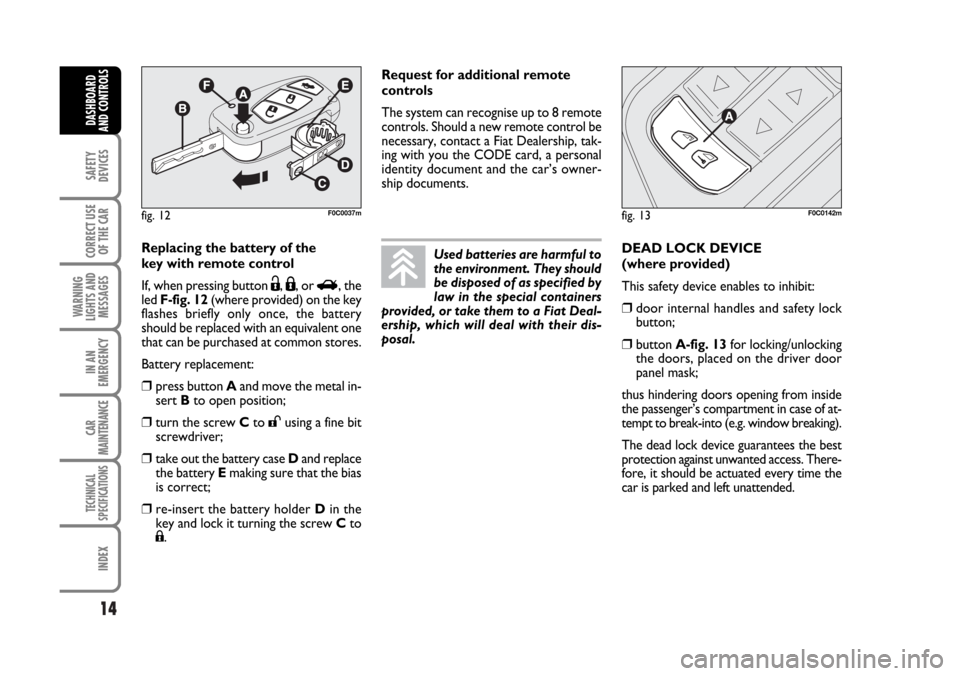
14
SAFETY
DEVICES
CORRECT USE
OF THE CAR
WARNING
LIGHTS AND
MESSAGES
IN AN
EMERGENCY
CAR
MAINTENANCE
TECHNICAL
SPECIFICATIONS
INDEX
DASHBOARD
AND CONTROLS
Replacing the battery of the
key with remote control
If, when pressing button
Ë, Á, or R, the
led F-fig. 12(where provided) on the key
flashes briefly only once, the battery
should be replaced with an equivalent one
that can be purchased at common stores.
Battery replacement:
❒press button Aand move the metal in-
sert Bto open position;
❒turn the screw Cto :using a fine bit
screwdriver;
❒take out the battery case Dand replace
the battery Emaking sure that the bias
is correct;
❒re-insert the battery holder Din the
key and lock it turning the screw Cto
;.Request for additional remote
controls
The system can recognise up to 8 remote
controls. Should a new remote control be
necessary, contact a Fiat Dealership, tak-
ing with you the CODE card, a personal
identity document and the car’s owner-
ship documents.
DEAD LOCK DEVICE
(where provided)
This safety device enables to inhibit:
❒door internal handles and safety lock
button;
❒button A-fig. 13for locking/unlocking
the doors, placed on the driver door
panel mask;
thus hindering doors opening from inside
the passenger’s compartment in case of at-
tempt to break-into (e.g. window breaking).
The dead lock device guarantees the best
protection against unwanted access. There-
fore, it should be actuated every time the
car is parked and left unattended.
fig. 12F0C0037m
Used batteries are harmful to
the environment. They should
be disposed of as specified by
law in the special containers
provided, or take them to a Fiat Deal-
ership, which will deal with their dis-
posal.
fig. 13F0C0142m
Page 16 of 274
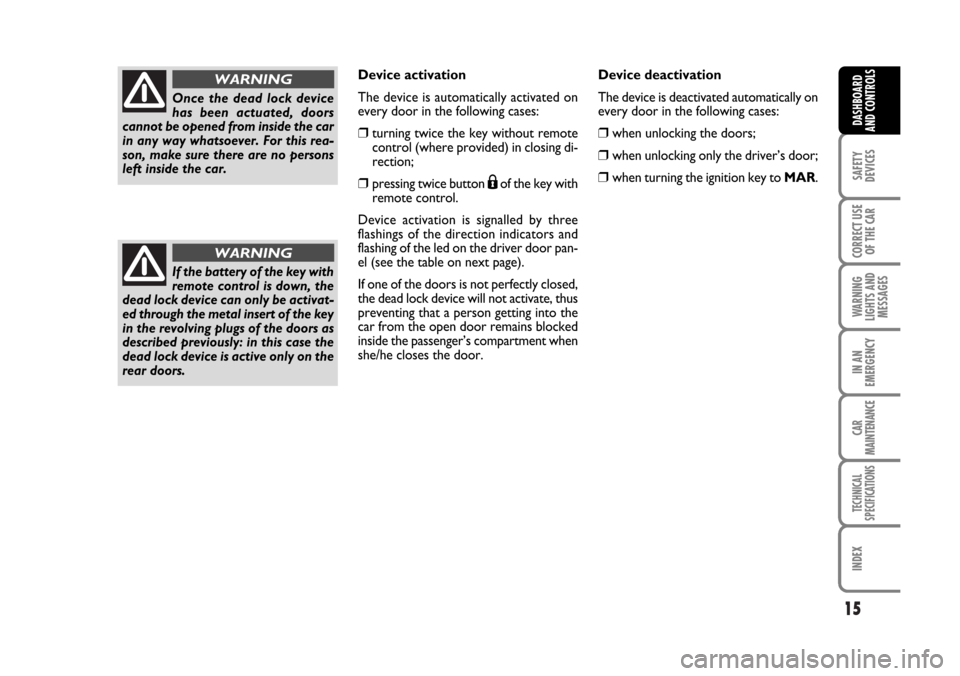
15
SAFETY
DEVICES
CORRECT USE
OF THE CAR
WARNING
LIGHTS AND
MESSAGES
IN AN
EMERGENCY
CAR
MAINTENANCE
TECHNICAL
SPECIFICATIONS
INDEX
DASHBOARD
AND CONTROLS
Device activation
The device is automatically activated on
every door in the following cases:
❒turning twice the key without remote
control (where provided) in closing di-
rection;
❒pressing twice button Áof the key with
remote control.
Device activation is signalled by three
flashings of the direction indicators and
flashing of the led on the driver door pan-
el (see the table on next page).
If one of the doors is not perfectly closed,
the dead lock device will not activate, thus
preventing that a person getting into the
car from the open door remains blocked
inside the passenger’s compartment when
she/he closes the door.Device deactivation
The device is deactivated automatically on
every door in the following cases:
❒when unlocking the doors;
❒when unlocking only the driver’s door;
❒when turning the ignition key to MAR.
Once the dead lock device
has been actuated, doors
cannot be opened from inside the car
in any way whatsoever. For this rea-
son, make sure there are no persons
left inside the car.
WARNING
If the battery of the key with
remote control is down, the
dead lock device can only be activat-
ed through the metal insert of the key
in the revolving plugs of the doors as
described previously: in this case the
dead lock device is active only on the
rear doors.
WARNING
Page 17 of 274
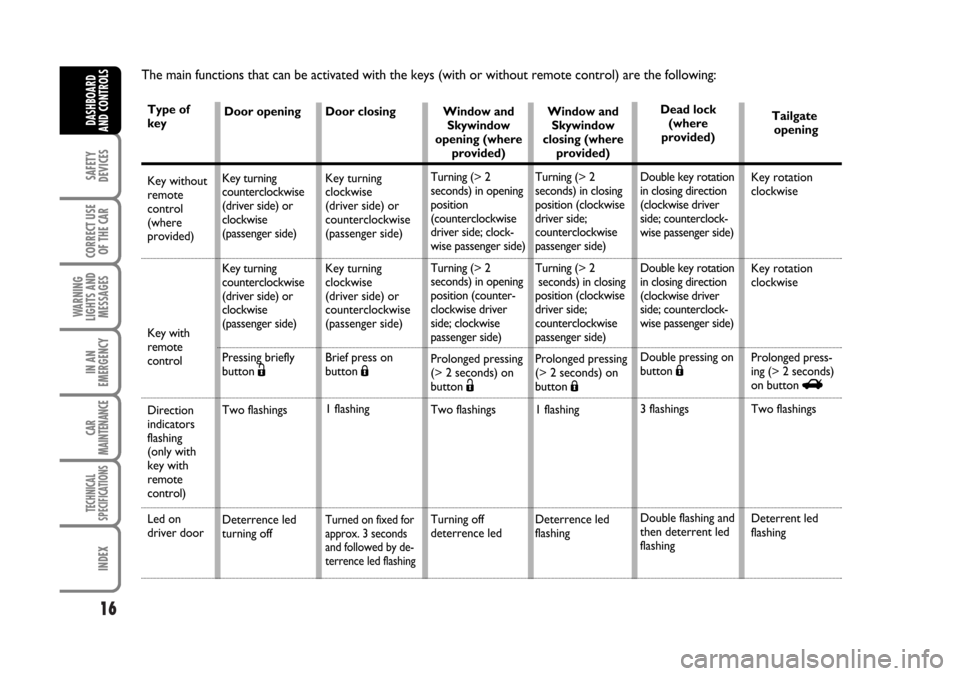
16
SAFETY
DEVICES
CORRECT USE
OF THE CAR
WARNING
LIGHTS AND
MESSAGES
IN AN
EMERGENCY
CAR
MAINTENANCE
TECHNICAL
SPECIFICATIONS
INDEX
DASHBOARD
AND CONTROLS
The main functions that can be activated with the keys (with or without remote control) are the following:
Door opening
Key turning
counterclockwise
(driver side) or
clockwise
(passenger side)
Key turning
counterclockwise
(driver side) or
clockwise
(passenger side)
Pressing briefly
button Ë
Two flashings
Deterrence led
turning offDoor closing
Key turning
clockwise
(driver side) or
counterclockwise
(passenger side)
Key turning
clockwise
(driver side) or
counterclockwise
(passenger side)
Brief press on
button Á
1 flashing
Turned on fixed for
approx. 3 seconds
and followed by de-
terrence led flashing
Window and
Skywindow
opening (where
provided)
Turning (> 2
seconds) in opening
position
(counterclockwise
driver side; clock-
wise passenger side)
Turning (> 2
seconds) in opening
position (counter-
clockwise driver
side; clockwise
passenger side)
Prolonged pressing
(> 2 seconds) on
button Ë
Two flashings
Turning off
deterrence ledWindow and
Skywindow
closing (where
provided)
Turning (> 2
seconds) in closing
position (clockwise
driver side;
counterclockwise
passenger side)
Turning (> 2
seconds) in closing
position (clockwise
driver side;
counterclockwise
passenger side)
Prolonged pressing
(> 2 seconds) on
button Á
1 flashing
Deterrence led
flashingDead lock
(where
provided)
Double key rotation
in closing direction
(clockwise driver
side; counterclock-
wise passenger side)
Double key rotation
in closing direction
(clockwise driver
side; counterclock-
wise passenger side)
Double pressing on
button Á
3 flashings
Double flashing and
then deterrent led
flashingTailgate
opening
Key rotation
clockwise
Key rotation
clockwise
Prolonged press-
ing (> 2 seconds)
on button R
Two flashings
Deterrent led
flashingType of
key
Key without
remote
control
(where
provided)
Key with
remote
control
Direction
indicators
flashing
(only with
key with
remote
control)
Led on
driver door
Page 18 of 274

17
SAFETY
DEVICES
CORRECT USE
OF THE CAR
WARNING
LIGHTS AND
MESSAGES
IN AN
EMERGENCY
CAR
MAINTENANCE
TECHNICAL
SPECIFICATIONS
INDEX
DASHBOARD
AND CONTROLS
ALARM
(where provided)
The alarm function is provided in addition
to all remote control functions previous-
ly described and it is controlled by the re-
ceiver located under the dashboard, next
to the fuse box.
WHEN THE ALARM IS
TRIGGERED
The alarm comes into action in the fol-
lowing cases:
❒ unlawful opening of one of the doors,
bonnet or boot (perimetral protec-
tion);
❒attempt to start the engine (turning the
ignition key to MAR);
❒ battery cable cutting;
❒ presence of moving bodies in the pas-
senger’s compartment (volumetric pro-
tection);
❒ abnormal raising/sloping of the car. Depending on the markets, the cutting in
of the alarm causes operation of the siren
and direction indicators (for about 26 sec-
onds). The ways of operating and the num-
ber of cycles may vary depending on the
markets.
A maximum number of sound/sight cycles
is however envisaged.
Volumetric and anti-raising protections
can be cut off by operating the front ceil-
ing light controls (see paragraphs “Volu-
metric protection sensors” and “Anti-rais-
ing sensor” on the following pages).
IMPORTANT The engine immobiliser
function is guaranteed by the Fiat CODE
system, which is automatically activated
when the ignition key is removed.HOW TO ACTIVATE THE
ALARM
With the doors, bonnet and boot shut and
the ignition key in the STOPposition or
with the key removed, point the key with
remote control in the direction of the car,
then press and release the button
Á.
With the exception of certain markets,
the system sounds a “beep” and the doors
are locked.
Engagement of the alarm is preceded by
a self-diagnostic test. If a fault is detected
the system sounds a further warning
“beep” and the display shows the relevant
message (see section “Warning lights and
messages”).
In this case, switch the alarm system off by
pressing button
Ë, check that the doors,
bonnet and tailgate are properly shut, then
switch the alarm on again by pressing but-
ton
Á.
Otherwise, the door, bonnet or tailgate
that is not shut properly will be excluded
from the alarm system control.
Page 19 of 274
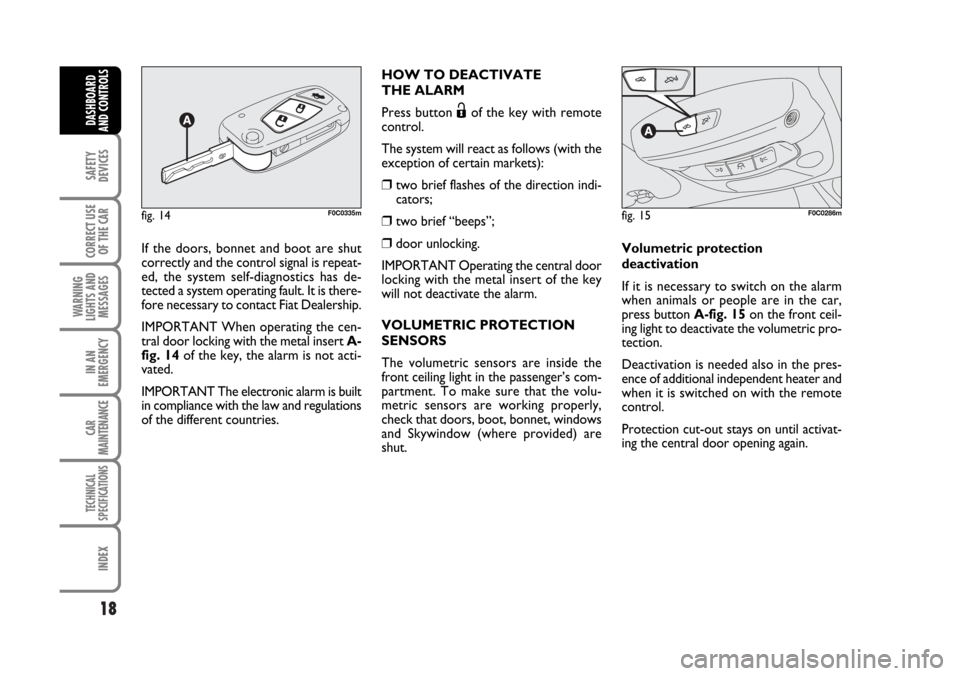
18
SAFETY
DEVICES
CORRECT USE
OF THE CAR
WARNING
LIGHTS AND
MESSAGES
IN AN
EMERGENCY
CAR
MAINTENANCE
TECHNICAL
SPECIFICATIONS
INDEX
DASHBOARD
AND CONTROLS
If the doors, bonnet and boot are shut
correctly and the control signal is repeat-
ed, the system self-diagnostics has de-
tected a system operating fault. It is there-
fore necessary to contact Fiat Dealership.
IMPORTANT When operating the cen-
tral door locking with the metal insert A-
fig. 14of the key, the alarm is not acti-
vated.
IMPORTANT The electronic alarm is built
in compliance with the law and regulations
of the different countries.HOW TO DEACTIVATE
THE ALARM
Press button
Ëof the key with remote
control.
The system will react as follows (with the
exception of certain markets):
❒ two brief flashes of the direction indi-
cators;
❒ two brief “beeps”;
❒door unlocking.
IMPORTANT Operating the central door
locking with the metal insert of the key
will not deactivate the alarm.
VOLUMETRIC PROTECTION
SENSORS
The volumetric sensors are inside the
front ceiling light in the passenger’s com-
partment. To make sure that the volu-
metric sensors are working properly,
check that doors, boot, bonnet, windows
and Skywindow (where provided) are
shut.Volumetric protection
deactivation
If it is necessary to switch on the alarm
when animals or people are in the car,
press button A-fig. 15 on the front ceil-
ing light to deactivate the volumetric pro-
tection.
Deactivation is needed also in the pres-
ence of additional independent heater and
when it is switched on with the remote
control.
Protection cut-out stays on until activat-
ing the central door opening again.
fig. 14F0C0335mfig. 15F0C0286m
Page 20 of 274
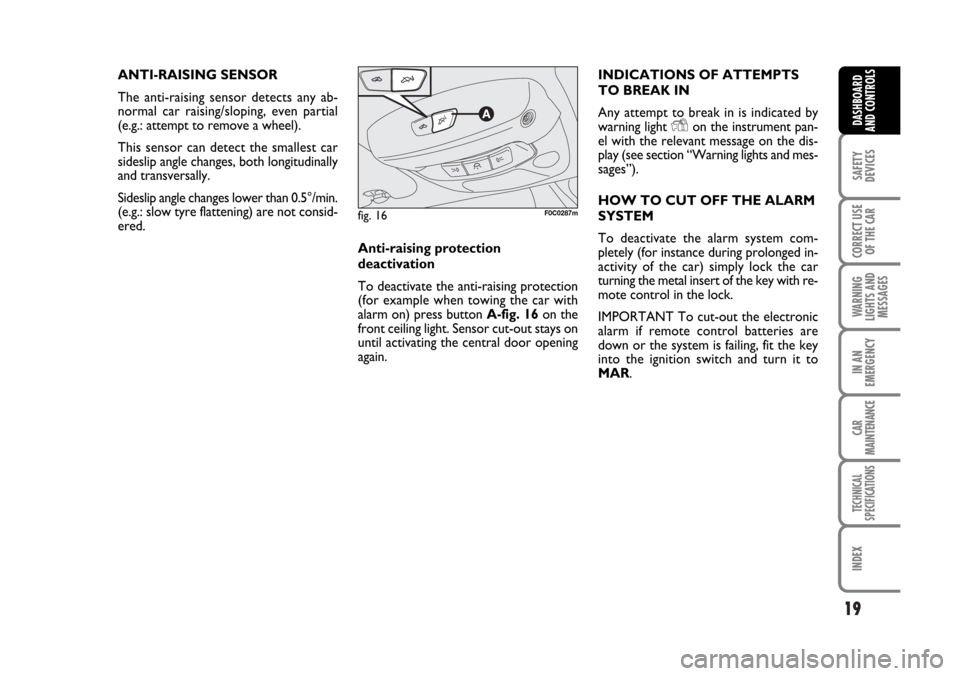
19
SAFETY
DEVICES
CORRECT USE
OF THE CAR
WARNING
LIGHTS AND
MESSAGES
IN AN
EMERGENCY
CAR
MAINTENANCE
TECHNICAL
SPECIFICATIONS
INDEX
DASHBOARD
AND CONTROLS
ANTI-RAISING SENSOR
The anti-raising sensor detects any ab-
normal car raising/sloping, even partial
(e.g.: attempt to remove a wheel).
This sensor can detect the smallest car
sideslip angle changes, both longitudinally
and transversally.
Sideslip angle changes lower than 0.5°/min.
(e.g.: slow tyre flattening) are not consid-
ered.
Anti-raising protection
deactivation
To deactivate the anti-raising protection
(for example when towing the car with
alarm on) press button A-fig. 16 on the
front ceiling light. Sensor cut-out stays on
until activating the central door opening
again.INDICATIONS OF ATTEMPTS
TO BREAK IN
Any attempt to break in is indicated by
warning light
Yon the instrument pan-
el with the relevant message on the dis-
play (see section “Warning lights and mes-
sages”).
HOW TO CUT OFF THE ALARM
SYSTEM
To deactivate the alarm system com-
pletely (for instance during prolonged in-
activity of the car) simply lock the car
turning the metal insert of the key with re-
mote control in the lock.
IMPORTANT To cut-out the electronic
alarm if remote control batteries are
down or the system is failing, fit the key
into the ignition switch and turn it to
MAR.
fig. 16F0C0287m
Page 21 of 274
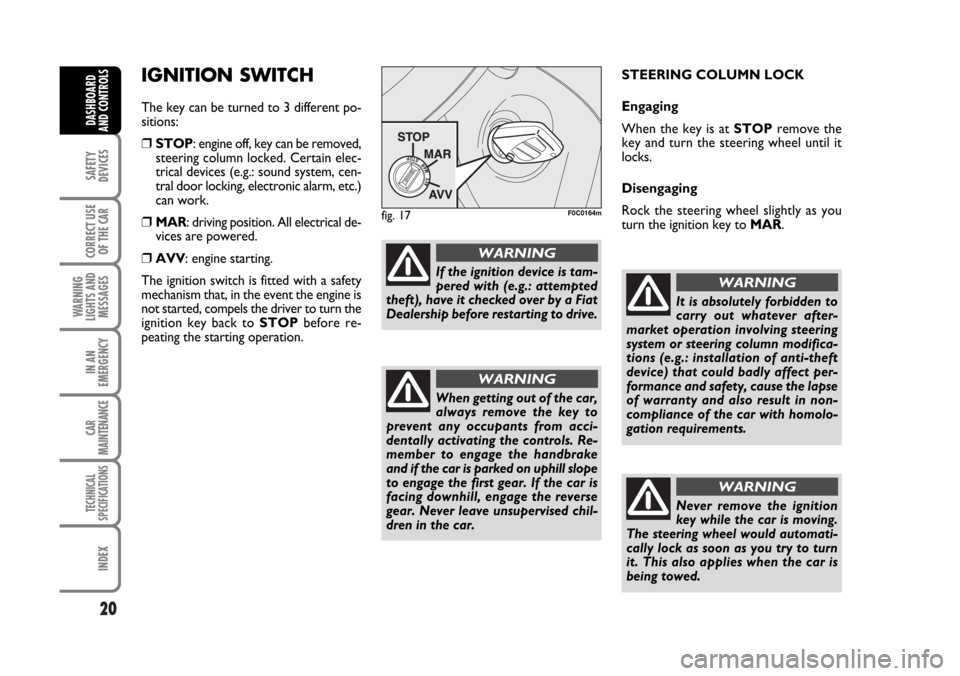
20
SAFETY
DEVICES
CORRECT USE
OF THE CAR
WARNING
LIGHTS AND
MESSAGES
IN AN
EMERGENCY
CAR
MAINTENANCE
TECHNICAL
SPECIFICATIONS
INDEX
DASHBOARD
AND CONTROLS
IGNITION SWITCH
The key can be turned to 3 different po-
sitions:
❒STOP: engine off, key can be removed,
steering column locked. Certain elec-
trical devices (e.g.: sound system, cen-
tral door locking, electronic alarm, etc.)
can work.
❒MAR: driving position. All electrical de-
vices are powered.
❒AVV: engine starting.
The ignition switch is fitted with a safety
mechanism that, in the event the engine is
not started, compels the driver to turn the
ignition key back to STOPbefore re-
peating the starting operation.STEERING COLUMN LOCK
Engaging
When the key is at STOPremove the
key and turn the steering wheel until it
locks.
Disengaging
Rock the steering wheel slightly as you
turn the ignition key to MAR.
fig. 17F0C0164m
If the ignition device is tam-
pered with (e.g.: attempted
theft), have it checked over by a Fiat
Dealership before restarting to drive.
WARNING
When getting out of the car,
always remove the key to
prevent any occupants from acci-
dentally activating the controls. Re-
member to engage the handbrake
and if the car is parked on uphill slope
to engage the first gear. If the car is
facing downhill, engage the reverse
gear. Never leave unsupervised chil-
dren in the car.
WARNING
It is absolutely forbidden to
carry out whatever after-
market operation involving steering
system or steering column modifica-
tions (e.g.: installation of anti-theft
device) that could badly affect per-
formance and safety, cause the lapse
of warranty and also result in non-
compliance of the car with homolo-
gation requirements.
WARNING
Never remove the ignition
key while the car is moving.
The steering wheel would automati-
cally lock as soon as you try to turn
it. This also applies when the car is
being towed.
WARNING
Page 22 of 274
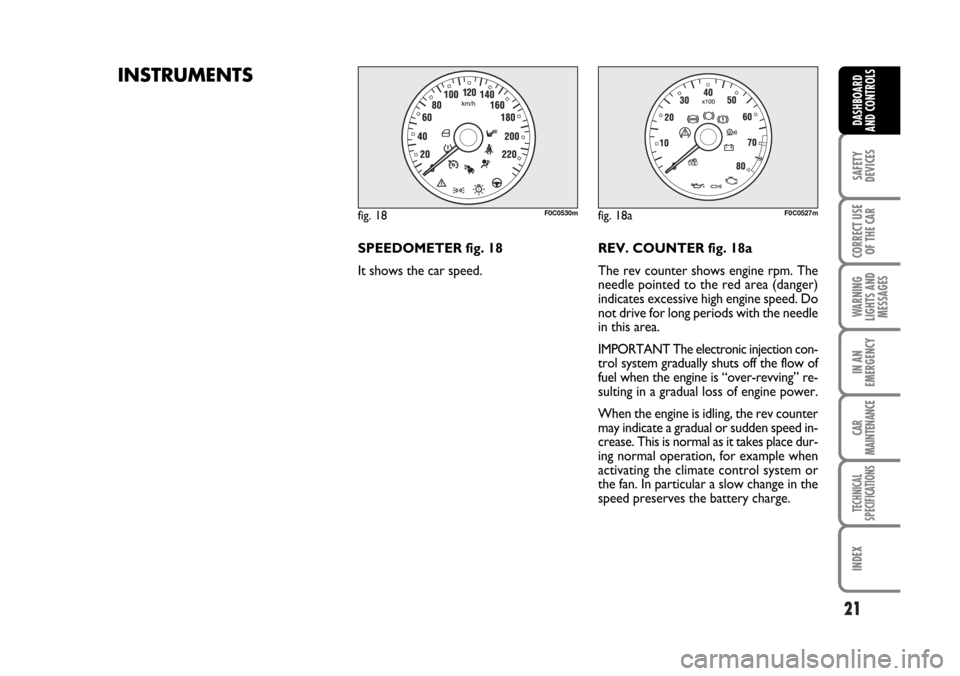
21
SAFETY
DEVICES
CORRECT USE
OF THE CAR
WARNING
LIGHTS AND
MESSAGES
IN AN
EMERGENCY
CAR
MAINTENANCE
TECHNICAL
SPECIFICATIONS
INDEX
DASHBOARD
AND CONTROLS
INSTRUMENTS
REV. COUNTER fig. 18a
The rev counter shows engine rpm. The
needle pointed to the red area (danger)
indicates excessive high engine speed. Do
not drive for long periods with the needle
in this area.
IMPORTANT The electronic injection con-
trol system gradually shuts off the flow of
fuel when the engine is “over-revving” re-
sulting in a gradual loss of engine power.
When the engine is idling, the rev counter
may indicate a gradual or sudden speed in-
crease. This is normal as it takes place dur-
ing normal operation, for example when
activating the climate control system or
the fan. In particular a slow change in the
speed preserves the battery charge.
fig. 18aF0C0527mfig. 18F0C0530m
SPEEDOMETER fig. 18
It shows the car speed.
Page 23 of 274
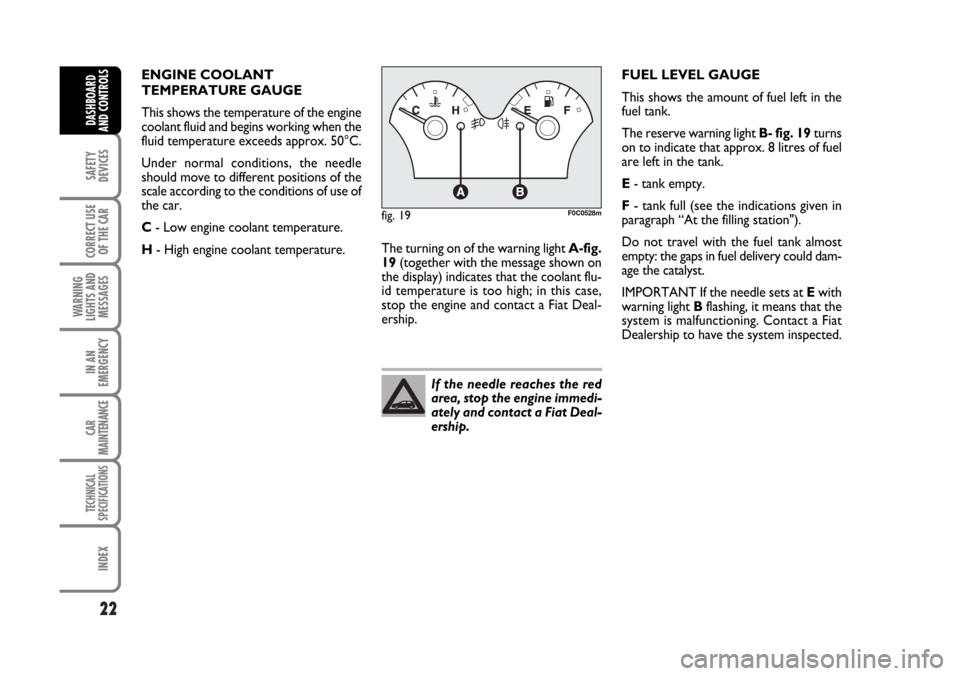
22
SAFETY
DEVICES
CORRECT USE
OF THE CAR
WARNING
LIGHTS AND
MESSAGES
IN AN
EMERGENCY
CAR
MAINTENANCE
TECHNICAL
SPECIFICATIONS
INDEX
DASHBOARD
AND CONTROLS
If the needle reaches the red
area, stop the engine immedi-
ately and contact a Fiat Deal-
ership.
fig. 19F0C0528m
ENGINE COOLANT
TEMPERATURE GAUGE
This shows the temperature of the engine
coolant fluid and begins working when the
fluid temperature exceeds approx. 50°C.
Under normal conditions, the needle
should move to different positions of the
scale according to the conditions of use of
the car.
C- Low engine coolant temperature.
H- High engine coolant temperature.FUEL LEVEL GAUGE
This shows the amount of fuel left in the
fuel tank.
The reserve warning light B- fig. 19turns
on to indicate that approx. 8 litres of fuel
are left in the tank.
E- tank empty.
F- tank full (see the indications given in
paragraph “At the filling station").
Do not travel with the fuel tank almost
empty: the gaps in fuel delivery could dam-
age the catalyst.
IMPORTANT If the needle sets at Ewith
warning light Bflashing, it means that the
system is malfunctioning. Contact a Fiat
Dealership to have the system inspected. The turning on of the warning light A-fig.
19(together with the message shown on
the display) indicates that the coolant flu-
id temperature is too high; in this case,
stop the engine and contact a Fiat Deal-
ership.
Page 24 of 274
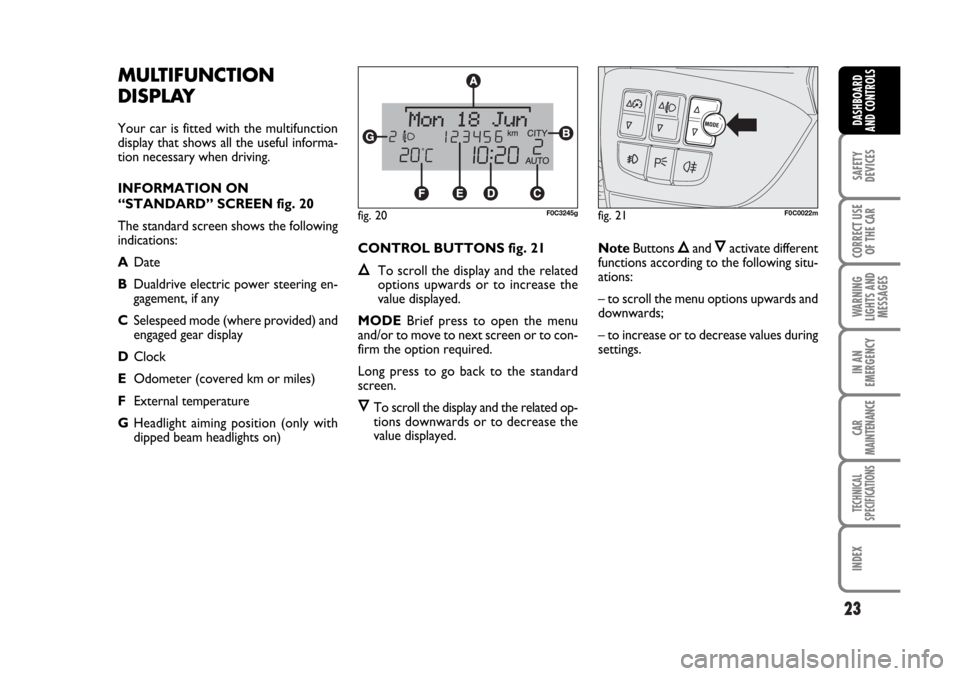
23
SAFETY
DEVICES
CORRECT USE
OF THE CAR
WARNING
LIGHTS AND
MESSAGES
IN AN
EMERGENCY
CAR
MAINTENANCE
TECHNICAL
SPECIFICATIONS
INDEX
DASHBOARD
AND CONTROLS
MULTIFUNCTION
DISPLAY
Your car is fitted with the multifunction
display that shows all the useful informa-
tion necessary when driving.
INFORMATION ON
“STANDARD” SCREEN fig. 20
The standard screen shows the following
indications:
ADate
BDualdrive electric power steering en-
gagement, if any
CSelespeed mode (where provided) and
engaged gear display
DClock
EOdometer (covered km or miles)
FExternal temperature
GHeadlight aiming position (only with
dipped beam headlights on) CONTROL BUTTONS fig. 21
ÕTo scroll the display and the related
options upwards or to increase the
value displayed.
MODEBrief press to open the menu
and/or to move to next screen or to con-
firm the option required.
Long press to go back to the standard
screen.
ÔTo scroll the display and the related op-
tions downwards or to decrease the
value displayed.NoteButtons
Õand Ôactivate different
functions according to the following situ-
ations:
– to scroll the menu options upwards and
downwards;
– to increase or to decrease values during
settings.
fig. 21F0C0022mfig. 20F0C3245g